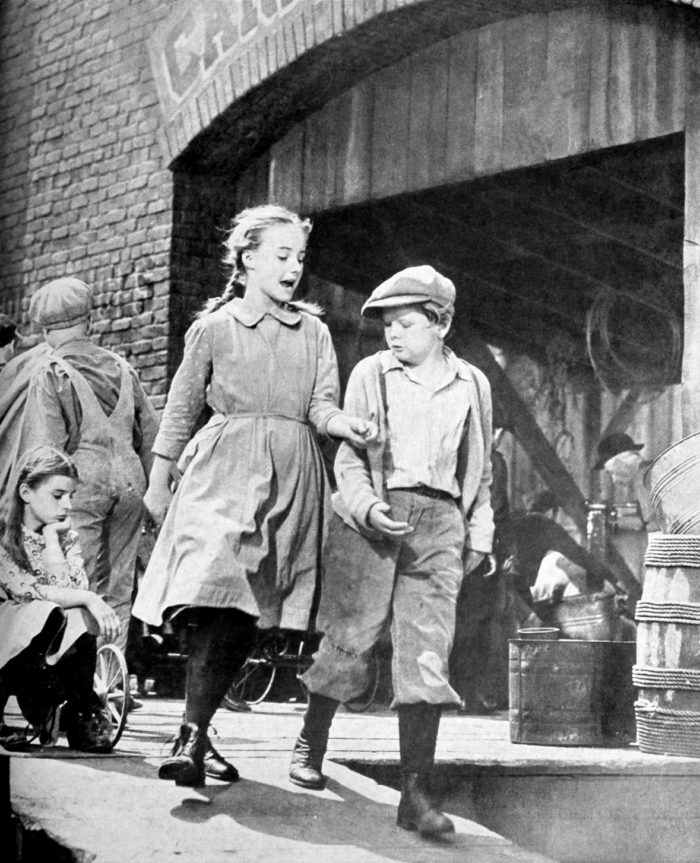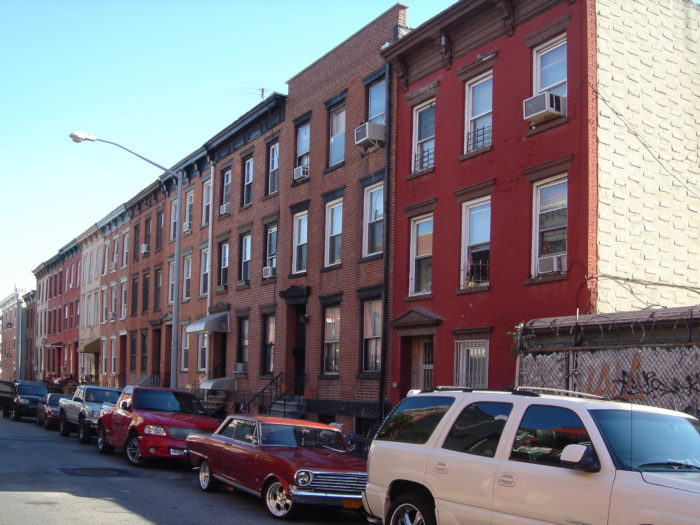Set in the years from 1900 to 1917, “A Tree Grows in Brooklyn” is without doubt the most famous depiction of Williamsburg in fiction. But the best-selling novel—and the subsequent film adaptations—is not the only fictional work to take place in the neighborhood. Writers as diverse as Henry Miller and Chaim Potok have also immortalized Williamsburg.
The first novel by Betty Smith, “A Tree Grows in Brooklyn” describes Williamsburg in precise, loving detail. Just a few pages in, we are treated to a walking tour of Manhattan Avenue, past Scholes and Messerole Streets, down to a five-and-dime on Broadway, then east to Graham Avenue, brimming with pushcart vendors. The Williamsburg Bridge, Knipe’s drugstore on Grand Street (now the site of a law office), Phillip’s Lyceum Theater on Montrose Avenue (demolished to make room for P.S. 250), McCarren Park, the Grand Street trolley, the Woronov jewelry store on Grand Street (now occupied by Hush Life shoe store), and the Williamsburgh Savings Bank (placed on the National Register of Historic Places in 2008) are among the neighborhood locales that appear in the book.
A still from the 1945 film adaptation of “A Tree Grows in Brooklyn.” Image: public domain/Wikimedia
Though populated primarily by immigrants and first-generation Americans, the Williamsburg of protagonist Francie Nolan—and of Smith herself, who like Francie was born and raised in the neighborhood—was not so much a melting pot as a collection of micro-neighborhoods: Montrose and Johnson Avenues were exclusively Italian, north of that was predominately German and Irish, the area from Siegel Street south past Broadway was Jewish.
“The Chosen” by Chaim Potok takes place in the Jewish section of Williamsburg in the mid to late 1940s. Even this micro-neighborhood, however, has subdivisions, “each with its own rabbi, its own little synagogue, its own customs, its own fierce loyalties,” as noted on the first page of the novel. While “The Chosen” does not call out specific locales and businesses the way “A Tree Grows in Brooklyn,” it nonetheless paints an equally vivid portrait of a different aspect of the neighborhood, where boys wearing yarmulkes played sandlot baseball, Yiddish was as common as English, and on Saturdays the sidewalks of Lee Avenue were thick with men in long dark coats walking to and from synagogue.
Like Smith, Henry Miller was from Williamsburg. Like “A Tree Grows in Brooklyn,” much of his autobiographical novel “Tropic of Capricorn” is set in Williamsburg in the first several decades of the 20th century. Unlike Smith, though, Miller rarely waxed nostalgic about the neighborhood. He described Fillmore Place, a one-block street between Roebling Street and Driggs Avenue (until the age of nine he lived at 662 Driggs, across the street from Fillmore), as “the ideal street for a boy, a lover, a maniac, a drunkard, a crook, a lecher, a thug, an astronomer, a musician, a poet, a tailor, a shoemaker, a politician.” While that could perhaps be taken as a backhanded compliment, there is nothing complimentary about another description of the street; he claimed that with its 19th-century brick rowhouses, it looked “like a dirty mouth with all the prominent teeth missing, with ugly charred stumps gaping here and there, the lips rotting, the palate gone.” Apparently not everyone agreed with the description, as Fillmore Place—and a stretch of Driggs Avenue that includes Miller’s childhood home—was made a city Historic District in 2009.
Fillmore Place. Image: Sarah/Flickr
Taking place in the mid-1990s, “The Sunshine Crust Baking Factory” by Stacy Wakefield depicts the period when many of Williamsburg’s abandoned industrial buildings had yet to be converted to residences and shops. The narrator sets up a squat in one of those buildings near the Brooklyn-Queens Expressway. Wakefield’s previous book, “Not for Rent,” was a nonfiction account of squatters, and this account of the neighborhood’s former squatter community is less a tale of sex, drugs, and rock-and-roll and more a story of heavy lifting and street politics.
For a 21st-century account of Williamsburg, look no further than “Solos” by Kitty Burns Florey. Similar to “A Tree Grows in Brooklyn,” it opens with a walking tour, this time of Bedford Avenue, as the protagonist, Emily, and her dog pass “the sushi place, the Mexican restaurant, the video store, the Syrian deli, the Polish bakery… the new baby shop that has a pair of studded black booties in the window…” The details are limned as lovingly as those of “A Tree Grows in Brooklyn”; Emily lives in a former spice factory at North Third and Berry Streets (where Florey used to live), Vera Cruz restaurant on Bedford Avenue makes an appearance, and McCarren Park—which also appeared in Smith’s book—is a prominent setting. Though it takes place nearly a century after “A Tree Grows in Brooklyn,” “Solos” shares with it a love of the neighborhood that is just as diverse now as it was then.




